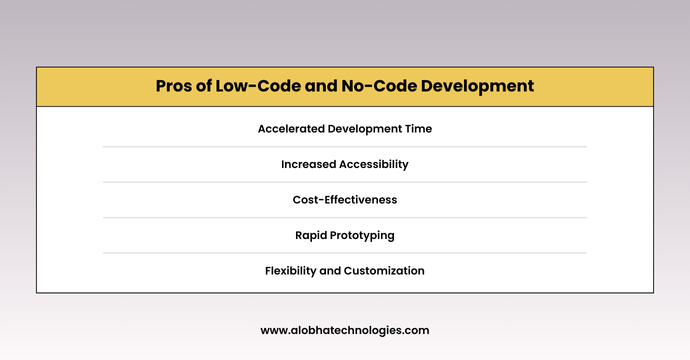
In the realm of software development, innovation is ceaselessly driving the industry forward. One of the latest trends shaking up the landscape is the emergence of low-code and no-code development platforms.
These solutions promise to democratize the process of building software by empowering individuals with varying levels of technical expertise to create applications with ease. In this blog post, we’ll delve into the pros and cons of low-code and no-code development, exploring how these platforms are reshaping the way software is built and maintained.
Understanding Low-Code and No-Code Development
Before diving into the advantages and disadvantages, let’s clarify what low-code and no-code development actually entail.
Low-Code Development
Low-code platforms streamline the software development process by providing visual, drag-and-drop interfaces that allow developers to build applications with minimal hand-coding. These platforms often include pre-built templates, components, and integrations, speeding up development time significantly.
No-Code Development
No-code platforms take simplification a step further by enabling users with little to no coding experience to create functional applications. These platforms typically offer a user-friendly interface and require no coding whatsoever, relying instead on visual builders and predefined logic modules.
Pros of Low-Code and No-Code Development

- Accelerated Development Time: Low-code and no-code platforms excel at speeding up the development process. By removing the necessity for manual coding and offering pre-built components, developers can build applications much faster than with traditional development methods.
- Increased Accessibility: One of the most significant benefits of low-code and no-code development is its accessibility. These platforms empower individuals with varying levels of technical expertise, including citizen developers, business analysts, and subject matter experts, to participate in the application development process.
- Cost-Effectiveness: By reducing the reliance on highly skilled developers and accelerating development time, low-code and no-code platforms can lead to cost savings for organizations. Additionally, many of these platforms offer subscription-based pricing models, making them more affordable for businesses of all sizes.
- Rapid Prototyping: Low-code and no-code platforms are ideal for rapid prototyping and iterative development. With the ability to quickly build and test applications, developers can gather feedback from stakeholders early in the process and make necessary adjustments without significant time or resource investment.
- Flexibility and Customization: While low-code and no-code platforms provide pre-built components and templates, they also offer flexibility for customization. Developers can extend the functionality of these platforms by integrating with third-party services, writing custom code when needed, and adapting the user interface to meet specific requirements.
Read More: Advantages of Hiring the Best Software Development Company in India
Cons of Low-Code and No-Code Development
- Limited Complexity: While low-code and no-code platforms excel at simplifying the development process, they may not be suitable for building highly complex or specialized applications. These platforms often have limitations in terms of scalability, performance, and functionality, which can hinder their suitability for certain use cases.
- Vendor Lock-In: Relying on a specific low-code or no-code platform may result in vendor lock-in, where organizations become dependent on the platform provider for ongoing support and maintenance. Switching to a different platform or transitioning to traditional development methods can be challenging and costly.
- Reduced Control and Flexibility: With the convenience of pre-built components and visual interfaces comes a trade-off in control and flexibility. Developers may find themselves constrained by the limitations of the platform, unable to implement custom solutions or optimize performance to the same extent as with traditional coding methods.
- Security Concerns: Low-code and no-code platforms often prioritize ease of use over robust security measures. While these platforms may offer built-in security features, they may not provide the same level of protection as custom-built applications. Organizations must carefully evaluate the security implications of using low-code and no-code platforms for sensitive or mission-critical applications.
- Learning Curve: While low-code and no-code platforms are designed to be user-friendly, there is still a learning curve associated with mastering these tools. Individuals with no prior development experience may require training and support to effectively utilize these platforms, potentially slowing down the adoption process.
Conclusion
In conclusion, low-code and no-code development platforms offer a compelling solution for organizations looking to accelerate the software development process and increase accessibility.
However, it’s essential to weigh the advantages and disadvantages carefully and consider the suitability of these platforms for specific use cases.
The blog “Explore Pros & Cons of Low-Code and No-Code Development” on Alobha Technologies’ website provides a balanced analysis of these development platforms. It highlights the benefits, such as accelerated development time, increased accessibility, cost-effectiveness, rapid prototyping, and flexibility. However, it also addresses the drawbacks, including limited complexity, vendor lock-in, reduced control, security concerns, and a learning curve for new users.